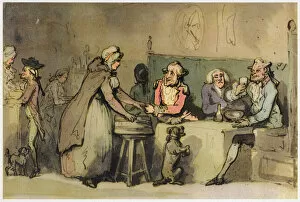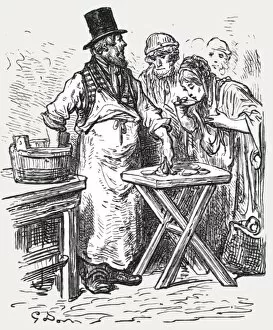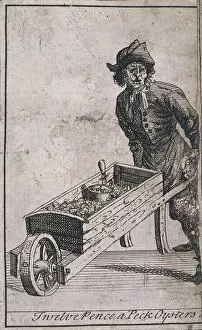Oyster Seller Collection
"The Oyster Seller: A Glimpse into the Vibrant World of Regency England" Step back in time to Regency England
For sale as Licensed Images
Choose your image, Select your licence and Download the media
"The Oyster Seller: A Glimpse into the Vibrant World of Regency England" Step back in time to Regency England, where bustling streets were filled with a myriad of tradespeople. Among them, the oyster seller stood out as an iconic figure, immortalized by renowned artists such as Thomas Rowlandson and Henry Robert Morland. In the late 18th century, Thomas Rowlandson captured the essence of this trade with his masterpiece "The Oyster Woman. " This vivid depiction showcases a woman skillfully shucking oysters while surrounded by eager customers. The painting not only highlights her expertise but also sheds light on the significance of oysters during that era. During wheat harvest season, when fields were abundant with golden crops, these hardworking individuals would take a break from their laborious tasks to relish fresh oysters brought straight from the sea. It was a delightful treat that added flavor and variety to their monotonous diet. Henry Robert Morland's "Oyster Girl" further emphasizes this culinary delight. With her charming smile and basket full of succulent oysters, she entices passersby to indulge in this exquisite delicacy. Her presence on London's streets adds color and vibrancy to an otherwise ordinary day. As time progressed, Gustave Doré's portrayal of "The Oysterman" in 1872 reveals how this trade evolved over decades. With his rugged appearance and sturdy cart brimming with freshly caught oysters, he symbolizes resilience amidst changing times. To truly understand the cultural significance of oyster sellers in London's history, we must explore Paul Sandby's captivating artwork titled "Two Oyster Sellers. " Created in 1760 as part of his famous series "Cries of London, " it portrays two women passionately advertising their wares through melodic cries echoing across busy streets. Even earlier than that is Bouchardon's enchanting piece titled "Oysters in the Shell. " from 1737-1742.












